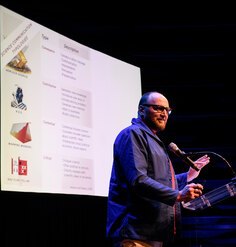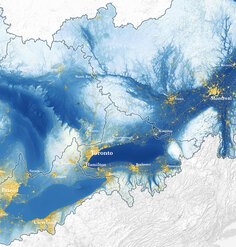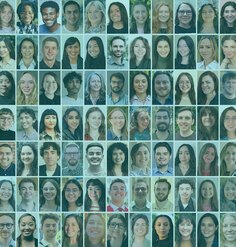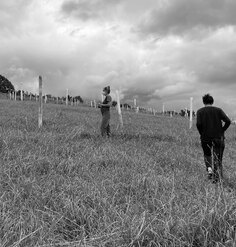LAF Fellowship Spotlight: It Started in the Park
As Johnny Macon walked down Whitelock Street in Baltimore’s Reservoir Hill neighborhood, he pointed to gardens and greenhouses on two adjacent corners – community-driven projects that helped revitalize the area. Just up the street, people sat in the shade outside the St. Francis Neighborhood Center to escape the summer heat. Beyond a row of nearby trees, a basketball court and green space spread out inside German Park, redesigned and redeveloped in recent years with new grass where concrete once laid, a walking path, exercise equipment, and playgrounds donated by the Baltimore Ravens.
For Johnny, a lecturer at Morgan State University, the basketball court at German Park is a special place. He grew up next to the park, helped redesign it while working with Baltimore-based Neighborhood Design Center, and is now examining the court as a case study in his 2023-24 LAF Fellowship for Innovation and Leadership project, titled “It Started in the Park: Preserving the Cultural Identity of Basketball Courts as Centers of Socialization for Historically Black Urban Communities.” The yearlong project is giving Johnny the opportunity to research how basketball courts situated in urban parks in major cities served as place-makers and incubators for the development of Black culture during the 1970s through the 1990s.
“I chose this topic, first of all, because it’s something that helps me tie in what really inspired me to be a landscape architect, which is namely this park – growing up and playing in this park, and just knowing how much the game of basketball, this court, and courts in many parts of the city are community cornerstones, and they’re not studied or understood enough in terms of their cultural impact and not just a place to play,” Johnny said.
Johnny plans to document and examine the role that landscape architecture played in shaping these spaces. He’s analyzing park typologies, usage, and how these places are viewed by different communities. He also will conduct interviews and gather historical and social documentation of the general cultural impact of basketball and outdoor recreation so he ultimately can generate educational methodologies to transmit and value this history.
“We know that sometimes basketball courts can be victims of the ‘not in my backyard’ mentality,” Johnny said. “People don’t always like the activity and I believe a lot of that has to do with a lack of appreciation for their cultural significance. So, my research is really telling that story about how courts like this were the incubators of the music, dance, fashion, and language that have gone on to spread around the world."
German Park is situated near the center of the neighborhood. It was built in the late 1970s, with concrete covering much of the space and wooden playground equipment reflective of the time, Johnny said. He remembers riding his bike around the park as a child and playing basketball on the court, though he jokes his best position was “spectator.”
The neighborhood was bustling back then with local businesses including grocery stores, pharmacies, a barber shop, and a fish market. Eventually, the neighborhood fell on hard times, with an open-air drug market, crime, and violence troubling the area. Buildings were abandoned and eventually torn down to leave vacant, overgrown lots. As the surrounding streets became plagued by crime, so too did German Park, Johnny said.
German Park had been cut off from the neighborhood with a concrete wall in the 1990s. In the early 2000s, when access to the park was regained, crime and illicit activity restarted, Johnny said. The park experienced ebbs and flows of crime and revitalization, with a significant step being a partnership between the Baltimore Ravens and community leaders to demolish a portion of the park and build a new playground. This playground served as an anchor for continued growth, and over the subsequent decade the park continued to evolve, culminating with a significant redesign through a partnership between the St. Francis Center, the Baltimore City Department of Planning INSPIRE Program, the Reservoir Hill Improvement Council, and the Neighborhood Design Center. German Park became a safe space for children and the broader community.
“It was a significant exercise in community-driven design,” Johnny said.
As Johnny walked around the park, women pushed children on swings at the playground. Pedestrians passed through on the walking path. A man hung out and listened to music. A woman worked in one of the community gardens next-door.
“We’ve developed and grown a green infrastructure that’s the center of our neighborhood,” Johnny said.
Through it all, the basketball court at German Park remained a constant for the local community, just as courts have done for generations in urban communities across the U.S., Johnny said. About five blocks away, Cloverdale Park serves as another case study for Johnny. The courts at Cloverdale have their own unique characteristics, which Johnny is examining with the same methodologies he’s using at German Park.
Looking ahead, Johnny is excited about the yearlong Fellowship process. Only a few months into it, he already is learning a lot and said the experience has been valuable from a professional standpoint, but also personally.
“For me to be here right now means a lot,” he said. “It’s a validation of all the effort that we have put into our community and it’s an opportunity for me to bring together all these different experiences and make sure a different voice is heard – as a professional and as a user of these spaces, as well as being able to amplify the voice of the community. Their perspective and their experience is of the highest value and I always put the people first.”
Members of the 2023-2024 cohort of the LAF Fellowship for Innovation and Leadership have been exploring their big ideas and advancing their proposed projects. The Fellows will present the culmination of their work at LAF’s Innovation + Leadership Symposium in June 2024 in Washington, DC. In the meantime, LAF is profiling each Fellow to share more about their progress and personal journeys.











